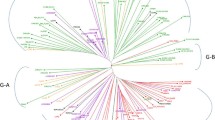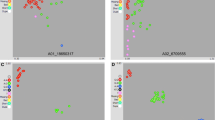Abstract
Studies on tropical popcorn (Zea mays L. ssp. mays) gene pools are still scarce. The objective of this study was to infer tropical popcorn gene pools by employing molecular and phenotypic information. Forty-eight inbred lines and 140 individuals belonging to the Viçosa and Beija-Flor popcorn populations were genotyped using 90 simple sequence repeat (SSR) and 93 single nucleotide polymorphism (SNP) markers, respectively. Grain yield and expansion volume were analyzed for the inbred lines and the hybrids obtained from intra- and interpopulation diallels. The cluster analysis based on SSR markers grouped 46 inbred lines into two groups according to their origin population. Principal coordinate and population structure analyses based on SSR and SNP markers confirmed the results from the clustering. For grain yield, midparent heterosis was greater in the interpopulation hybrids than in the intrapopulation hybrids. The genetic distance did not correlate with the specific combining ability effects and showed a week to intermediate correlation with hybrid performance and midparent heterosis. Based on the results from clustering, population structure, genetic diversity, heterosis and diallel analyses, Viçosa and Beija-Flor populations belong to distinct gene pools. Furthermore, inferring tropical popcorn gene pools might be more efficient if molecular marker and phenotypic data are combined.



Similar content being viewed by others
References
Adeyemo O, Menkir A, Melaku G, Omidiji O (2011) Genetic diversity assessment and relationship among tropical-yellow endosperm maize inbred lines using SSR markers. Maydica 56:1703
Babu R, Nair SK, Kumar A, Rao HS, Verma P, Gahala A, Singh IS, Gupta HS (2006) Mapping QTL for popping ability in a popcorn × flint corn cross. Theor Appl Genet 112:1392–1399
Badu-Apraku B, Oyekunle M, Fakorede MAB, Vroh I, Akinwale RO, Aderounmu M (2013) Combining ability, heterotic pattern and genetic diversity of extra-early yellow inbreds under contrasting environments. Euphytica 192:413–433
Barata C, Carena MJ (2006) Classification of North Dakota maize inbred lines into heterotic groups based on molecular and testcross data. Euphytica 151:339–349
Barbosa AMM, Geraldi IO, Benchimol LL, Garcia AAF, Souza CL Jr, Souza AP (2003) Relationship of intra- and interpopulation tropical maize single cross hybrid performance and genetic distances computed from AFLP and SSR markers. Euphytica 130:87–99
Bernardo R (1992) Relationship between single-cross performance and molecular marker heterozygosity. Theor Appl Genet 83:628–634
Betrán FJ, Ribaut JM, Beck D, de Gonzalez Leon D (2003) Genetic diversity, specific combining ability and heterosis in tropical maize under stress and nonstress environments. Crop Sci 43:797–806
Bracco M, Lia VV, Gottlieb AM, Hernández JC, Poggio L (2009) Genetic diversity in maize landraces from indigenous settlements of Northeastern Argentina. Genetica 135:39–49
Browning SR, Browning BL (2007) Rapid and accurate haplotype phasing and missing data inference for whole genome association studies using localized haplotype clustering. Am J Hum Genet 81:1084–1097. doi:10.1086/521987
Calinski T, Harabsz J (1974) A dendrite method for cluster analysis. Commun Stat 3:1–27
Chae SS, Warde WD (2006) Effect of using principal coordinates and principal components on retrieval of clusters. Comput Stat Data Anal 50:1407–1417
CIMMYT (2005) Laboratory protocols: CIMMYT applied molecular genetics laboratory, 3rd edn. CIMMYT, Mexico
Devi P, Singh NK (2011) Heterosis, molecular diversity, combining ability and their interrelationships in short duration maize (Zea mays L.) across the environments. Euphytica 178:71–81
Dhliwayo T, Pixley K, Menkir A, Warburton M (2009) Combining ability, genetic distances, and heterosis among elite CIMMYT and IITA tropical maize inbred lines. Crop Sci 49:1201–1210
Evanno G, Regnaut S, Goudet J (2005) Detecting the number of clusters of individuals using the software STRUCTURE: a simulation study. Mol Ecol 14:2611–2620
Fan JB, Gunderson KL, Bibikova M, Yeakley JM, Chen J, Garcia EW, Lebruska LL, Laurent M, Shen R, Barker D (2006) Illumina universal bead arrays. Methods Enzymol 410:57–73
Flint-Garcia SA, Buckler ES, Tiffin P, Ersoz E, Springer NM (2009) Heterosis in prevalent for multiple traits in diverse maize germplasm. PLoS ONE 10:e7433. doi:10.1371/journal.pone.0007433
Gilmour AR, Gogel BJ, Cullis BR, Thompson R (2009) ASReml user guide. Release 3.0. VSN International Ltd., Hemel Hempstead
Li YL, Lv DB, Wang YZ, Chen SJ, Tang JH (2004) Study on the genetic diversity of popcorn inbreds and their germplasm relationship with normal corn inbreds using SSR markers. Maydica 49:327–333
Li YL, Dong YB, Niu SZ, Cui DQ (2007) QTL for popping characteristics in popcorn. Plant Breed 126:509–514
Liu K, Goodman M, Muse S, Smith JS, Buckler ES, Doebley J (2003) Genetic structure and diversity among maize inbred lines as inferred from DNA microsatellites. Genetics 165:2117–2128
Lu HJ, Bernardo R, Ohm HW (2003) Mapping QTL for popping expansion volume in popcorn with simple sequence repeat markers. Theor Appl Genet 106:423–427
Lu YL, Yan JB, Guimarães CT, Taba S, Hao ZF, Gao SB, Chen SJ, Li JS, Zhang SH, Vivek BS, Magorokosho C, Mugo S, Makumbi D, Parentoni SN, Shah T, Rong TZ, Crouch JH, Xu YB (2009) Molecular characterization of global maize breeding germplasm based on genome-wide single nucleotide polymorphisms. Theor Appl Genet 120:93–115
Lynch ML (1990) The similarity index and DNA fingerprinting. Mol Biol Evol 7:478–484
Makumbi D, Betrán JF, Bänziger M, Ribaut JM (2011) Combining ability, heterosis and genetic diversity in tropical maize (Zea mays L.) under stress and non-stress conditions. Euphytica 180:143–162
Matsuoka Y, Mitchell SE, Kresovich S, Goodman M, Doebley J (2002) Microsatellites in Zea—variability, patterns of mutations, and use for evolutionary studies. Theor Appl Genet 104:436–450
Munhoz REF, Prioli AJ, Amaral Júnior AT, Scapim CA, Simon GA (2009) Genetic distance between popcorn populations based on molecular markers and correlations with heterosis estimates made by diallel analysis of hybrids. Genet Mol Res 8:951–962
Osorno JM, Carena MJ (2008) Creating groups of maize genetic diversity for grain quality: implications for breeding. Maydica 53:131–141
Peakall R, Smouse PE (2006) GENALEX 6: genetic analysis in excel. Population genetic software for teaching and research. Mol Ecol Notes 6:288–295
Pritchard JK, Stephens M, Donnelly P (2000) Inference of population structure using multilocus genotype data. Genetics 155:945–959
Reif JC, Melchinger AE, Xia XC, Warburton ML, Hoisington DA, Vasal SK, Beck D, Bohn M, Frisch M (2003a) Use of SSRs for establishing heterotic groups in subtropical maize. Theor Appl Genet 107:947–957
Reif JC, Melchinger AE, Xia XC, Warburton ML, Hoisington DA, Vasal SK, Srinivasan G, Bohn M, Frisch M (2003b) Genetic distance based on simple sequence repeats and heterosis in tropical maize populations. Crop Sci 43:1275–1282
Reif JC, Hallauer AR, Melchinger AE (2005) Heterosis and heterotic patterns in maize. Maydica 50:215–223
Rohlf FJ (2009) NTSYSpc: numerical taxonomy and multivariate analysis system. Exeter Softw, New York
Rosenberg NA (2004) DISTRUCT: a program for the graphical display of population structure. Mol Ecol Notes 4:137–138
Santacruz-Varela A, Widrlechner MP, Ziegler KE, Salvador RJ, Millard MJ, Bretting PK (2004) Phylogenetic relationships among North American popcorns and their evolutionary links to Mexican and South American popcorns. Crop Sci 44:1456–1467
Senior ML, Murphy JP, Goodman MM, Stuber CW (1998) Utility of SSRs for determining genetic similarities and relationships in maize using an agarose gel system. Crop Sci 38:1088–1098
Sharma L, Prasanna BM, Ramesh B (2010) Analysis of phenotypic and microsatellite-based diversity of maize landraces in India, especially from the North East Himalayan region. Genetica 138:619–631
Solomon KF, Zeppa A, Mulugeta SD (2012) Combining ability, genetic diversity and heterosis in relation to F1 performance of tropically adapted shrunken (sh2) sweet corn lines. Plant Breed 131:430–436
Studer M (2013) WeightedCluster library manual: a practical guide to creating typologies of trajectories in the social sciences with R. LIVES working papers, 24. doi:10.12682/lives.2296-1658.2013.24
Van Inghelandt D, Melchinger AE, Lebreton C, Stich B (2010) Population structure and genetic diversity in a commercial maize breeding program assessed with SSR and SNP markers. Theor Appl Genet 120:1289–1299
Viana JMS, Valente MSF, Scapim CA, Resende MDV, Silva FF (2011) Genetic evaluation of tropical popcorn inbred lines using BLUP. Maydica 56:273–281
Viana JMS, Valente MSF, Silva FF, Mundim GB, Paes GP (2013) Efficacy of population structure analysis with breeding populations and inbred lines. Genetica 141:389–399
Xie C, Warburton M, Li M, Li X, Xiao M, Hao Z, Zhao Q, Zhang S (2008) An analysis of population structure and linkage disequilibrium using multilocus data in 187 maize inbred lines. Mol Breed 21:407–418
Yang X, Gao S, Xu S, Zhang Z, Prasanna BM, Li L, Li J, Yan J (2011) Characterization of a global germplasm collection and its potential utilization for analysis of complex quantitative traits in maize. Mol Breed 28:511–526
Zheng D, Van K, Lee S (2008) Molecular diversity and relationships among elite maize inbreds from US and CIMMYT populations and current heterotic groups in China. Hereditas 145:182–193
Acknowledgments
We thank the Foundation for Research Support of Minas Gerais State (Fapemig), the Brazilian Federal Agency for Support and Evaluation of Graduate Education (Capes) and the National Council for Scientific and Technological Development (CNPq) for financial support.
Author information
Authors and Affiliations
Corresponding author
Appendix
Appendix
-
BLUP analysis, partial diallel # title line
-
env 8 # environments
-
blo 3 # blocks
-
gv 11 !i !sort # general combining ability effects of Viçosa inbreds
-
gbf 12 !i !sort # general combining ability effects of Beija-Flor inbreds
-
sca 102 !i !sort # SCA effects
-
ev # expansion volume
-
gy # grain yield
-
s # s—60 # final stand—ideal stand
-
m # m—14.5 # grain moisture—14.5
-
Av.grm # additive relationship matrix for Viçosa inbreds
-
Abf.grm # additive relationship matrix for Beija-Flor inbreds
-
D.grm # dominance relationship matrix
-
vxbf.asd # data file
-
!maxit 100 # maximum number of iterations
-
ev ~ mu env env.blo !r giv(gv,1) 1 giv(gbf,2) 1 giv(sca,3) 1 gv.env gbf.env sca.env !f mv
-
#gy ~ mu env env.blo s m !r giv(gv,1) 1 giv(gbf,2) 1 giv(sca,3) 1 gv.env gbf.env sca.env !f mv
Rights and permissions
About this article
Cite this article
Mundim, G.B., Viana, J.M.S., Maia, C. et al. Inferring tropical popcorn gene pools based on molecular and phenotypic data. Euphytica 202, 55–68 (2015). https://doi.org/10.1007/s10681-014-1211-4
Received:
Accepted:
Published:
Issue Date:
DOI: https://doi.org/10.1007/s10681-014-1211-4




